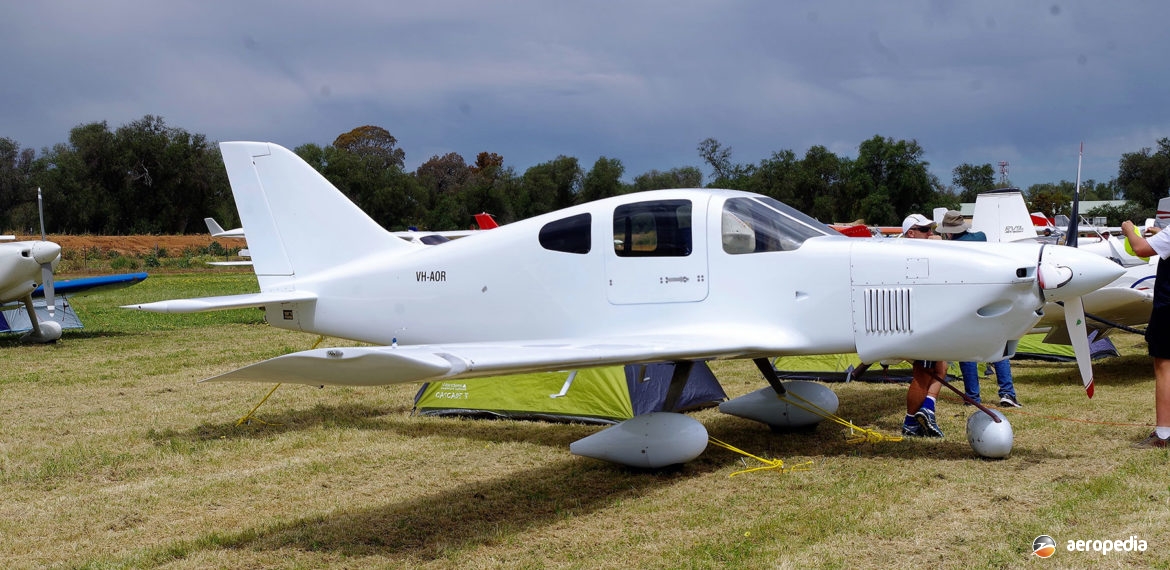Photograph:
First Team Foxtrot 4 completed in Australia VH-AOR (c/n 006) at Narromine, NSW in 2016 (David C Eyre)
Country of origin:
United States of America
Description:
Four-seat light touring monoplane
Power Plant:
One 260 kw (350 hp) Lycoming O-540 six-cylinder horizontally-opposed air-cooled engine
Specifications:
- Wingspan: 10.05 m (33 ft 0 in)
- Length: 7.55 m (24 ft 8 in)
- Height: 2.22 m (7 ft 3 in)
- Wing area: 11.89 m² (128 sq ft)
- Max speed: 368 km/h (229 mph)
- Max cruising speed: 348 km/h (216 mph)
- Stalling speed: 92 km/h (57mph)
- Rate of climb: 732 m/min (2,400 ft/min)
- Take-off ground roll: 183 m (600 ft)
- Landing ground roll: 244 m (800 ft)
- Fuel capacity standard: 420 litres (92 imp gals)
- Empty weight: 634 kg (1,398 lb)
- Full fuel payload: 320 kg (705 lb)
- Baggage capacity: 45 kg (100 lb)
- Loaded weight: 1,170 kg (2,579 lb)
History:
The Foxtrot 4 light high-performance sporting and touring monoplane was developed by Team Tango, a Company based at Williston, Florida, and owned by Revolution Aviation Inc. It was formed to produce light aircraft in kit form for amateur construction, the Company providing, if required, factory assistance. The first aircraft offered by the company was the Tango 2, a two-seater in side-by-side configuration, a composite aircraft available in kit form, which had a cruising speed of 337 km/h (209 mph), this aircraft being developed from the Aero Mirage TC-2.
The Foxtrot 4 was a four-seat variant of the Company’s Tango 2 and shared some of the Tango 2 aircraft’s features but was larger and was able to accommodate larger engines. It had a fixed tricycle undercarriage and an engine in the tractor configuration. The wing employed an NACA 64-415 aerofoil. Engines ranging from 149 kw (200 hp) to 261 kw (350 hp) from the Lycoming range have usually been installed driving a three-blade Hartzell propeller. One example in Florida was fitted with an all-aluminium Chevrolet LS-3 V-8 6.2 litre engine with an altitude compensating electronic fuel injector, a spur gear propeller speed reduction unit, and a fully automatic centrifugal clutch and flywheel assembly.
The prototype flew for the first time on 23 December 2002 and the aircraft was tested for certification purposes by test pilot, Dennis Funnemark. He described the aircraft as being light in pitch with good stability, roll being heavier than the Tango 2 but nimble compared to a Cessna 172, and quite stable.
A development of the Foxtrot was the Foxtrot XR, an extended range variant, this aircraft having a fuel capacity of up to 833 litres (184 Imp gals), a useful load of between 726 kg and 1,043 kg (1,600 lb and 2,300 lb), and the ability to fly up to 3,701 km (2,300 miles) with two persons on board with their luggage, having a maximum take-off weight of up to 1,905 kg (4,200 lb).
First aircraft of the series imported to Australia became VH-AOR³ (c/n 006) to its owner at Hamilton Central, QLD, on 27 January 2015. This aircraft was powered by a converted Chevrolet LS-1 V-8 engine driving an MT MTV-23-B propeller.

